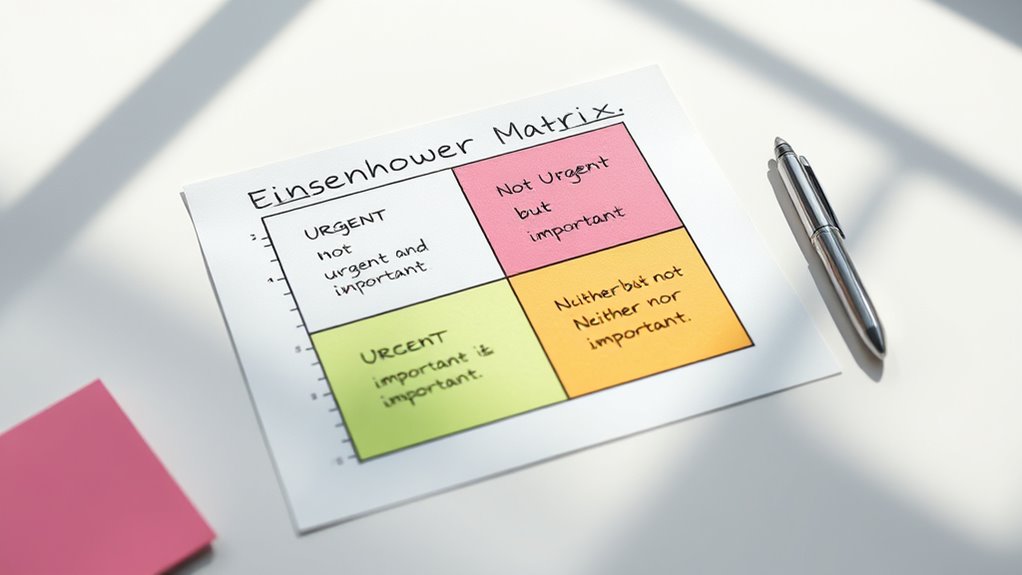The Eisenhower Matrix helps you distinguish urgent tasks from important ones, ensuring you focus on what truly matters. By categorizing tasks into four quadrants, you can prioritize effectively, prevent burnout, and spend your time on high-value activities. Recognizing the difference between immediate demands and long-term goals boosts your productivity and decision-making. To learn how to optimize this tool further, keep exploring the effective ways to apply it daily.
Key Takeaways
- Revisiting the matrix emphasizes the distinction between urgent tasks that demand immediate attention and important tasks that contribute to long-term goals.
- Prioritizing important but not urgent activities helps prevent crises and supports proactive, strategic planning.
- Recognizing “urgent” tasks often leads to reactive work, while “important” tasks foster growth and value creation.
- The revisited approach encourages regular assessment of tasks to maintain focus on high-impact activities over time.
- Understanding the contrast enhances decision-making, ensuring effort is aligned with priorities rather than merely reactive demands.

Have you ever struggled to prioritize tasks and stay organized? You’re not alone. Many people find it challenging to juggle multiple responsibilities, especially when everything seems urgent or important at once. That’s where the Eisenhower Matrix comes into play. It’s a simple yet powerful tool that helps you distinguish between what truly demands your attention and what can wait. By focusing on this distinction, you improve your time management and decision-making skills, ensuring you spend your energy on tasks that align with your goals.
The core idea behind the Eisenhower Matrix is to divide your tasks into four quadrants: urgent and important, important but not urgent, urgent but not important, and neither urgent nor important. When you recognize this structure, you gain clarity in decision making. You start to see which tasks require immediate action and which ones you can schedule for later or delegate. This not only prevents you from wasting time on trivial matters but also helps you allocate your resources wisely, leading to more effective use of your day.
Using the matrix sharpens your ability to assess each task’s significance quickly. When a new task appears, ask yourself: Is this urgent? Is it important? This habit improves your time management because you’re constantly evaluating priorities rather than reacting impulsively. Over time, this decision-making process becomes automatic, allowing you to focus on high-value activities instead of getting caught in the cycle of firefighting. The more you practice, the better you become at distinguishing between what’s truly essential and what’s merely distracting.
Moreover, the Eisenhower Matrix encourages proactive planning. By identifying important but not urgent tasks, you create space for strategic thinking and long-term growth. It helps you avoid the trap of always working in response mode, which often leads to burnout. Instead, you make intentional choices about how to use your time, ensuring that your daily activities align with your larger objectives. This approach fosters discipline and clarity, making it easier to say no to distractions and yes to what truly matters.
In essence, mastering the Eisenhower Matrix transforms how you approach your workload. It empowers you to make smarter decisions about your time management, letting you focus on impactful tasks rather than just urgent ones. When you regularly evaluate your priorities through this lens, you develop a more deliberate and efficient workflow. The result is greater productivity, less stress, and a clearer path toward achieving your goals. So, start applying the matrix today and see how your decision-making and time management improve with each use.
Additionally, understanding the contrast ratio of your projector can significantly enhance your viewing experience by providing deeper blacks and brighter highlights, especially in dark scenes.
Frequently Asked Questions
How Can I Effectively Prioritize Tasks Using the Eisenhower Matrix?
To effectively prioritize tasks, focus on task categorization and priority assessment. Break down your workload into urgent and important categories, then decide which tasks need immediate attention and which can be scheduled or delegated. Use the matrix to visualize these priorities, helping you avoid distractions and stay focused on high-impact activities. Regularly review and adjust your priorities to stay aligned with your goals and deadlines.
What Are Common Mistakes When Applying the Eisenhower Matrix?
When applying the Eisenhower Matrix, you might misclassify tasks or neglect urgency. Avoid thinking all important tasks are urgent, and vice versa. You could also spend too much time on low-priority tasks, or overlook deadlines. To prevent these mistakes, regularly review your tasks, consider their true importance and urgency, and stay flexible. This helps you prioritize effectively and focus on what truly matters.
How Does the Eisenhower Matrix Improve Long-Term Productivity?
You can improve your long-term productivity by using the Eisenhower Matrix to enhance your time management and strategic planning. It helps you prioritize tasks, focusing on what’s truly important rather than just urgent. By consistently addressing important activities, you build momentum and prevent burnout. Over time, this approach develops better habits, sharpens your decision-making skills, and guarantees you allocate your energy toward goals that contribute to sustained success.
Can the Eisenhower Matrix Be Adapted for Team Collaboration?
You can definitely adapt the Eisenhower Matrix for team collaboration by integrating team communication and collaborative decision making. When everyone understands how tasks are prioritized, it fosters clarity and accountability. Use the matrix to discuss priorities openly, ensuring all team members contribute to decision making. This approach streamlines workflows, improves transparency, and aligns your team’s efforts, ultimately boosting productivity and ensuring important tasks get the attention they deserve.
What Tools or Apps Support the Use of the Eisenhower Matrix?
Imagine your tasks as a symphony, each note needing perfect timing. Digital planners and task management apps like Todoist, Trello, and Asana act as conductors, guiding you through the rhythm of prioritization. They support the Eisenhower matrix by helping you categorize tasks effortlessly, ensuring urgent and important actions take center stage. With these tools, you orchestrate your day smoothly, turning chaos into harmony.
Conclusion
Now that you understand the Eisenhower Matrix, you realize it’s more than just sorting tasks—it’s about making choices that shape your future. But the real question remains: will you let urgency dictate your life, or will you prioritize what truly matters? The power is in your hands. Every decision you make today could lead to success or regret. So, what will you choose to focus on next? The answer might surprise you.









